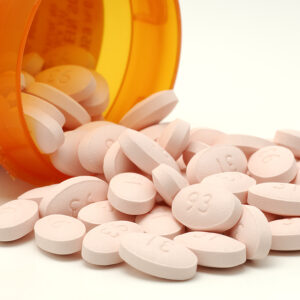The U.S. Department of Justice has charged five men from different states last month with being part of a $12 million drug-smuggling scheme, selling prescription drugs and steroids largely manufactured outside the United States.
But those men weren’t selling dope on street corners or in the local gym. They were doing it the 21st century way:
Online.
They were dealing on two different web domains— www.ExpressPCT.com and www.ExpressPEDS.ws. The drugs they sold needed supervision under a licensed practitioner, but the sites did not require prescriptions for purchase, the indictment said.
Now seized by the federal government, the sites were accessible — not via the Dark Web or secret log on — but by a simple Google search.
“Right now, you could google Percocet or Xanax and more than likely over half of those first-page search results would be an illegal pharmacy,” said John Hertig, professor of pharmacy practice at Butler University. According to Hertig, fake pharmaceutical websites like those two are not in the minority. Of the 35,000 online pharmacies, only 5 percent are operating legally, according to the Alliance for Safe Online Pharmacies.
Fake pharmacies are not looking to give consumers a good deal. United to Safeguard America from Illegal Trade spokesman Matt Albence said the sites are operated by drug cartels — some with ties to terrorism.
“They aren’t bound by any regulations or laws,” Albence said. “They have no care or concern for the individuals who may drastically suffer from utilizing their products.”
In 2017, 42 percent of consumers looked online for prescription medication, according to a study conducted by Hertig. Three years later, amid the pandemic, 78 percent of consumers were buying medications online.
With the boost in medical e-commerce, there is a great need for education not just for consumers, but for our health care professionals too, Hertig added. A 2021 published study revealed that over half of pharmacists could not confidently identify an illegal pharmaceutical site. The SAGE Publications study also revealed that 75 percent of pharmacists did not feel confident in directing patients to resources available for finding safe online pharmacies.
The fake pharmaceutical sites are counterfeiting everything from Viagra to Adderall, and consumers have no idea if what they are getting is safe, according to Hertig.
In 2021, the Drug Enforcement Agency seized enough fentanyl to provide a lethal dose to every American.
Targeting high schoolers and college-age kids, drug traffickers have also turned to social media platforms to sell recreational synthetic drugs. Marketed as MDMA or Xanax, those drugs end up being laced with fentanyl, Albence said.
Deaths tied to Fentanyl-laced pills have been connected to Snapchat in 17 states, according to the Partnership for Safe Medicines.
With the internet, there is no longer a need for a street drug dealer, said Kari Kammel with the Michigan State University Center for Anti-Counterfeiting and Product Protection.
“If you have someone based in China putting together counterfeit Xanax and lacing it with Fentanyl they can sell directly to consumers in small packages,” Kammel said. “Customs isn’t getting them through shipments in big sea freights. You don’t have drug-sniffing dogs looking for a small envelope package.”
Awarded a $1.75 million grant, UC San Diego professor Tim Mackey co-founded S-3 Research to combat drug traffickers on social media platforms and search engines — including Snapchat.
Drug traffickers will use keywords to attract consumers, and it is S-3 Research’s job to flag those sites and accounts. With drug traffickers constantly changing keywords, Mackey says platforms must work together.
“This is not one platform’s problem, it’s a whole ecosystem’s problem,” Mackey said. “Drug sellers are not just on one platform, they’re on multiple platforms. If you take them down on one platform, it doesn’t really impact their ability to reach customers.”
Sharing data — like certain keywords and how these keywords are changing over time — is crucial, Mackey said.
Cooperation between the private sector and law enforcement agencies is key, Albence said.
“There has to be a commitment by the social media platforms to participate and provide information to law enforcement so they can take the required action against these illegal actors.
While combating the cartels on the internet, the Southwest border must not be forgotten, Albence said.
“The cartel creates vulnerabilities,” Albence said. They will send 150 to 200 people across the border in a desolate location knowing that it will take up all the resources of the Border Patrol agents, allowing them the opportunity to smuggle their contraband.”
And now with a simple Google search, hashtag, drug cartels have direct access to consumers.
“I’ve talked to a number of families where their kids have died,” Hertig said. “They didn’t mean to do anything wrong, and they had no idea fentanyl was in the product. It was the night before an exam, and they never made it out of their room.”


